B0041VYHGW EBOK (93 page)
Authors: David Bordwell,Kristin Thompson

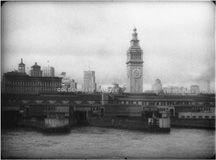
6.1 The first shot of
The Maltese Falcon
leads to …
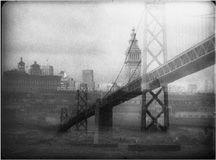
6.2 … a dissolve to …
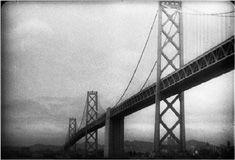
6.3 … the second shot.
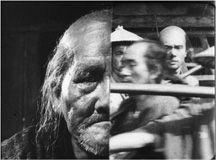
6.4 A wipe joins the last shot of one scene with the first of the next in
Seven Samurai.
The most common means of joining two shots is the
cut
. Until the rise of digital editing in the 1990s, a cut was made by splicing two shots together by means of film cement or tape. Some filmmakers “cut” during filming by planning for the film to emerge from the camera ready for final showing. Here the physical junction from shot to shot is created in the act of shooting. Such editing in the camera, however, is rare and is mainly confined to experimental and amateur filmmaking. Editing after shooting is the norm. Today most editing is done on computer, using footage stored on tape or a hard drive, so that the cuts (or
edits,
in video terminology) can be made without touching film. The final version of the film is prepared for printing by cutting and splicing the negative footage.
As viewers, we perceive a shot as an uninterrupted segment of screen time, space, or graphic configurations. Fades, dissolves, and wipes are perceived as gradually eliminating one shot and replacing it with another. Cuts are perceived as instantaneous changes from one shot to another.
“You can definitely help performances in the cutting room, by intercutting reaction, maybe re-recording lines, adding lines over reaction shots. And you can help a film’s structure by moving sequences about and dropping scenes that hold up pacing. And sometimes you can use bits and pieces from different takes, which also helps a lot. What you can do in the editing room to help a film is amazing.”
— Jodie Foster, actor and director
Consider four shots from the first attack on Bodega Bay in Alfred Hitchcock’s
The Birds
(
6.5
–
6.8
):
- Medium shot, straight-on angle.
Melanie, Mitch, and the Captain standing by the restaurant window talking. Melanie on extreme right, bartender in background (
6.5
). - Medium close-up.
Melanie by the Captain’s shoulder. She looks to right (out offscreen window) and up, as if following with her eyes. Pan right with her as she turns to window and looks out (
6.6
). - Extreme long shot.
Melanie’s point of view. Gas station across street, phone booth in left foreground. Birds dive-bomb attendant, right to left (
6.7
). - Medium close-up.
Melanie, profile. The Captain moves right into shot, blocking out bartender; Mitch moves right into extreme foreground. All in profile look out window (
6.8
).
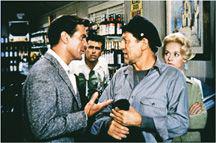
6.5
The Birds:
shot 1.
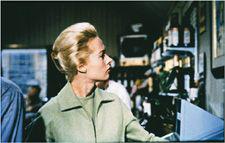
6.6
The Birds:
shot 2.
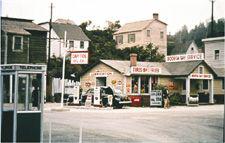
6.7
The Birds:
shot 3.
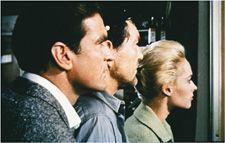
6.8
The Birds:
shot 4.
Each of these four shots presents a different segment of time, space, and pictorial information. The first shot shows three people talking. An instantaneous change—a cut—shifts us to a medium close-up shot of Melanie. Here space has changed (Melanie is isolated and larger in the frame), time is continuous, and the graphic configurations have changed (the arrangements of the shapes and colors vary). Another cut takes us instantly to what she sees. The gas station shot (
6.7
) presents a very different space, a successive bit of time, and a different graphic configuration. Another cut returns us to Melanie (
6.8
), and again we are shifted instantly to another space, the next slice of time, and a different graphic configuration. Thus the four shots are joined by three cuts.
Hitchcock could have presented the
Birds
scene without editing—as Jean Renoir might have done in a similar situation (
5.170
–
5.172
). Imagine a camera movement that frames the four people talking, tracks in and rightward to Melanie as she turns, pans rightward to the window to show the dive-bombing gull, and pans leftward back to catch the group’s expressions. This would constitute one shot. The camera movements, no matter how fast, would not present the marked and abrupt shifts that cuts produce. Now imagine a deep-space composition of the sort that Orson Welles might have used (
5.39
), presenting Mitch in the foreground, Melanie and the window in the middle ground, and the gull attack in the distance. Again, the scene could now be played in one shot, for we would have no abrupt change of time or space or graphics. And the movements of the figures would not yield the jumps in time, space, and composition provided by editing.
Although many films today are shot with several cameras running simultaneously, throughout film history most sequences have been shot with only one camera. In the
Birds
scene, for example, the shots were taken at different times and places—one (shot 3) outdoors, the others in a sound stage (and these perhaps on different days). A film editor thus must assemble a large and varied batch of footage. To ease this task, most filmmakers plan for the editing phase during the preparation and shooting phases. Shots are filmed with an idea of how they will eventually fit together. In fictional filming, scripts and storyboards help plan editing, while documentary filmmakers often shoot with an eye to how the footage will be cut.
Editing offers the filmmaker four basic areas of choice and control:
- Graphic relations between shot A and shot B
- Rhythmic relations between shot A and shot B
- Spatial relations between shot A and shot B
- Temporal relations between shot A and shot B
